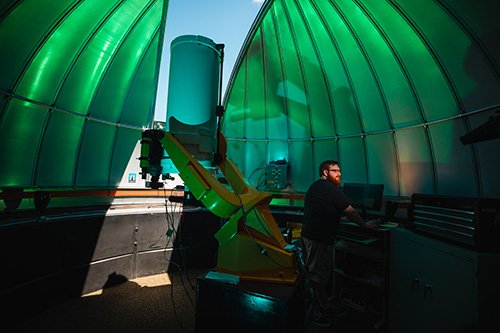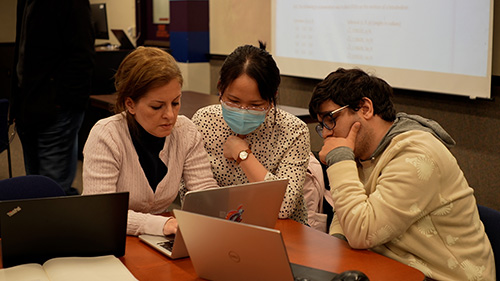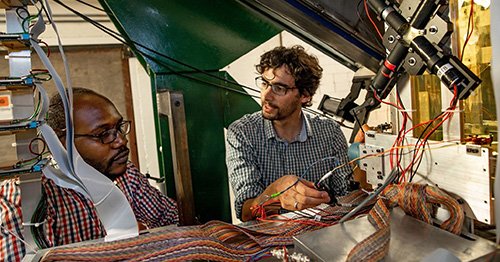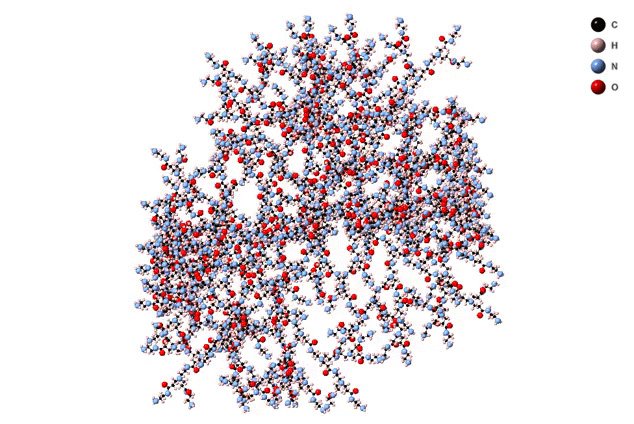Physics Research Opportunities
Roll up your sleeves, get involved in physics research, and enhance your education at Central Michigan University.
From studying stellar disc structures to connecting nuclear physics with possible habitable planets, you can find a lab or research team based on your interests. Build your professional network by collaborating with students from Western University in London, Canada. Move the needle closer to determining which Earth-like exoplanets could support life. Or dive into oxidation reactions, which are used to produce pharmaceuticals, agricultural chemicals and various functionalized hydrocarbon molecules, and play a vital role in the production of sustainable energy.
Research topics
Observational astronomy and astrophysics
 The Ancients believed the stars in our night sky to be perfect and unchanging. Many centuries later, we now view the sky very differently: it is extremely dynamic and variable, and the study of how the light that we see changes over time can provide invaluable insights into the nature of stars and other celestial objects. This is a particularly exciting time in astronomy, with the advent of multi-messenger astronomy (which includes the study of gravitational waves, neutrinos, and light), the discovery of innumerable worlds beyond our own – giving rise to exoplanetary science – and the development of state-of-the-art observatories (both space-based, like the James Webb Space Telescope, and ground-based, like the upcoming Thirty Meter Telescope and Vera C. Rubin Observatory), which will allow us to break new frontiers in astrophysics. Researchers at CMU specialize in the study of stars, in particular using the “time domain”, in other words characterizing their variability using repeated observations that span the electromagnetic spectrum. Students can take part in several different projects and roles, from gathering observations (with opportunities for hands-on observing experience at the Brooks Astronomical Observatory) to analyzing them, as well as performing numerical simulations, placing them on a path to contribute to the next wave of major discoveries in the study of our Universe.
The Ancients believed the stars in our night sky to be perfect and unchanging. Many centuries later, we now view the sky very differently: it is extremely dynamic and variable, and the study of how the light that we see changes over time can provide invaluable insights into the nature of stars and other celestial objects. This is a particularly exciting time in astronomy, with the advent of multi-messenger astronomy (which includes the study of gravitational waves, neutrinos, and light), the discovery of innumerable worlds beyond our own – giving rise to exoplanetary science – and the development of state-of-the-art observatories (both space-based, like the James Webb Space Telescope, and ground-based, like the upcoming Thirty Meter Telescope and Vera C. Rubin Observatory), which will allow us to break new frontiers in astrophysics. Researchers at CMU specialize in the study of stars, in particular using the “time domain”, in other words characterizing their variability using repeated observations that span the electromagnetic spectrum. Students can take part in several different projects and roles, from gathering observations (with opportunities for hands-on observing experience at the Brooks Astronomical Observatory) to analyzing them, as well as performing numerical simulations, placing them on a path to contribute to the next wave of major discoveries in the study of our Universe.
Computational materials
 Decipher the secrets of materials to save the planet! Many possible solutions to global warming hinge on creating better materials. For example, more of the sun’s energy could be harvested by using more efficient solar cell materials. Likewise, more solar and wind energy could be stored with improved battery materials. The search for these and other new materials is being guided by computer simulations that can predict the properties of potential materials before they are even synthesized. CMU Physics researchers are working to make these simulations as accurate as possible, by improving the quantum mechanics tools they are based on. Students participate in a range of projects from running simulations, to programming, to improving the theoretical models.
Decipher the secrets of materials to save the planet! Many possible solutions to global warming hinge on creating better materials. For example, more of the sun’s energy could be harvested by using more efficient solar cell materials. Likewise, more solar and wind energy could be stored with improved battery materials. The search for these and other new materials is being guided by computer simulations that can predict the properties of potential materials before they are even synthesized. CMU Physics researchers are working to make these simulations as accurate as possible, by improving the quantum mechanics tools they are based on. Students participate in a range of projects from running simulations, to programming, to improving the theoretical models.
Nuclear physics and astrophysics
 Nuclear physics research at CMU explores our universe from subatomic to cosmic scales. Neutrinos are one type of fundamental particle; the basic building blocks of the physical world. Their basic properties, in particular their mass and nature of their antiparticles, are still not well understood. At CMU we study nuclear processes, like neutrino-less double beta decay, that can help resolve these outstanding puzzles about neutrinos. Our other research focus area is nuclear astrophysics: the role of atomic nuclei in nuclear reaction processes driving the evolution and nucleosynthesis in stars. We study how nuclear processes during stellar explosions have synthesized the heavy chemical elements in our Galaxy, how nuclear processes shape the phenomena astronomers can observe from neutron stars in binary star systems, and the formation of long-lived radioactive isotopes that heat rocky planets as they are being formed. Our computational work involves large scale calculations of nuclear structure models and astrophysics simulations with nuclear reaction networks. Nuclear physics experiments take us to particle accelerators across the US and abroad. Closer to home, at CMU we perform high-precision measurements of atomic masses with the CHIP-TRAP spectrometer and work on developing novel radiation detectors.
Nuclear physics research at CMU explores our universe from subatomic to cosmic scales. Neutrinos are one type of fundamental particle; the basic building blocks of the physical world. Their basic properties, in particular their mass and nature of their antiparticles, are still not well understood. At CMU we study nuclear processes, like neutrino-less double beta decay, that can help resolve these outstanding puzzles about neutrinos. Our other research focus area is nuclear astrophysics: the role of atomic nuclei in nuclear reaction processes driving the evolution and nucleosynthesis in stars. We study how nuclear processes during stellar explosions have synthesized the heavy chemical elements in our Galaxy, how nuclear processes shape the phenomena astronomers can observe from neutron stars in binary star systems, and the formation of long-lived radioactive isotopes that heat rocky planets as they are being formed. Our computational work involves large scale calculations of nuclear structure models and astrophysics simulations with nuclear reaction networks. Nuclear physics experiments take us to particle accelerators across the US and abroad. Closer to home, at CMU we perform high-precision measurements of atomic masses with the CHIP-TRAP spectrometer and work on developing novel radiation detectors.
Condensed matter physics experiments
 A deep understanding of the properties of a material requires attacking the problem with a variety of experimental techniques. At CMU we characterize materials both for novel technologies and applications, and simply to better understand how the arrangement of atoms at the microscopic level defines the properties of the substances that make our material world. X-ray diffraction is a powerful tool to map the spatial distribution of atoms in crystals, molecules, or even water! We perform the experiments at both in-house facilities and at X-ray sources at National Laboratories. Our second area of research is electret polymers – plastics that can accumulate electric charges - and their many applications.
A deep understanding of the properties of a material requires attacking the problem with a variety of experimental techniques. At CMU we characterize materials both for novel technologies and applications, and simply to better understand how the arrangement of atoms at the microscopic level defines the properties of the substances that make our material world. X-ray diffraction is a powerful tool to map the spatial distribution of atoms in crystals, molecules, or even water! We perform the experiments at both in-house facilities and at X-ray sources at National Laboratories. Our second area of research is electret polymers – plastics that can accumulate electric charges - and their many applications.
Physics research resources
CMU Library Resource Guide
The CMU Library offers several avenues of research support. Through Document on Demand services, all faculty can take advantage of Desktop Delivery - whenever you need a copy of an article or a book chapter from the library print or microform collections, the library can scan it and send it to you electronically.
